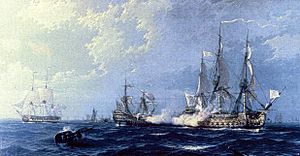Action of 8 April 1740 facts for kids
Quick facts for kids Action of 8 April 1740 |
|||||||
|---|---|---|---|---|---|---|---|
| Part of the War of Jenkins' Ear | |||||||
 Battle between the Spanish 70-gun Princesa (right foreground) and HMS Lenox, Orford and Kent, 8 April 1740, Museo Naval de Madrid |
|||||||
|
|||||||
| Belligerents | |||||||
| Commanders and leaders | |||||||
| Captain Colvill Mayne Captain Thomas Durell Captain Lord Augustus Fitzroy |
Don Pablo Augustín de Gera. | ||||||
| Strength | |||||||
| 3 third-rates | 1 third-rate | ||||||
| Casualties and losses | |||||||
| 17 killed, 40 wounded. | 1 ship captured 33 killed, 100 wounded 517 captured. |
||||||
The Action of 8 April 1740 was an important naval battle. It happened during the War of Jenkins' Ear. This war was fought between Great Britain and Spain.
The battle involved one Spanish ship, the Princesa. It was a large warship with 64 guns. The Spanish ship was commanded by Don Pablo Augustín de Gera. Three British warships fought against it. These ships were the HMS Kent, HMS Lenox, and HMS Orford. Each of these British ships had 70 guns. Captain Colvill Mayne led the British ships.
The British ships chased the Princesa and captured it. After the battle, the British Navy took the Princesa and used it as one of their own ships.
Contents
Why the Battle Happened
In March 1740, the British Navy got news. They heard that two Spanish ships had left Buenos Aires. These ships were sailing towards Spain. The British wanted to stop them.
So, three British warships were sent out. These were the HMS Kent, HMS Lenox, and HMS Orford. Captain Colvill Mayne was in charge of this group of ships. Other captains included Lord Augustus Fitzroy and Thomas Durell.
The ships left Portsmouth on March 29. They sailed down the English Channel. On April 8, Mayne's ships were patrolling the sea. They were about 300 miles southwest of The Lizard in England. That's when they saw a ship in the distance.
The Sea Battle Begins
The British ships sailed closer to the unknown ship. They found out it was the Spanish Princesa. It had 64 guns and a crew of 650 sailors. The Princesa had been flying French flags. But when the British got close, it changed to Spanish flags.
The British ships began to chase the Princesa at 10 AM. Captain Mayne spoke to his crew. He told them to fight bravely for their country. The chase lasted for two and a half hours.
Fighting the Princesa
Finally, the British ships caught up to the Princesa. They started firing their cannons at each other. This kind of fighting is called exchanging broadsides. The Princesa fought very hard. But eventually, the British ships damaged it badly.
The British ships then fired along the length of the Princesa. This is called raking. It caused a lot of damage. The Spanish ship could not fight anymore. It lowered its flags, which meant it surrendered.
Casualties and Injuries
The battle was tough for both sides. The Spanish Princesa had 33 sailors killed. About 100 more were wounded. The British also had casualties. Eight men died on the Kent. Another eight died on the Orford. One sailor died on the Lenox.
In total, 40 British sailors were wounded. Captain Durell of the Kent was one of them. He lost one of his hands during the fight.
What Happened Next
The captured Princesa was brought to Portsmouth on May 8, 1740. The British Navy decided to buy the ship. They paid a large sum of money for it.
The Princesa was then repaired and refitted. This process took many months. It cost a lot of money. The ship was very strong and well-built. People at the time said it was bigger than any British first-rate ship. It also had unusually large cannons.
The Princesa's strong fight against three British ships was very impressive. It was described as the finest ship in the Spanish Navy. Its design allowed it to open its lower gunports even in rough seas. This was something other ships couldn't do.
After its repairs, the ship was renamed HMS Princess. It served in the British Royal Navy for many years. The Princess was finally sold in 1784. It was taken apart for its materials.
Images for kids
-
The action from an engraving by Peter Monamy
See also
 In Spanish: Acción del 8 de abril de 1740 para niños
In Spanish: Acción del 8 de abril de 1740 para niños


